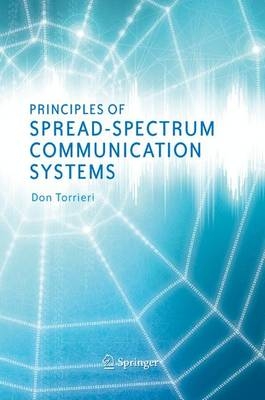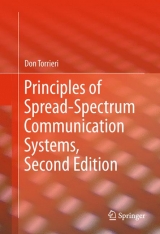
Principles of Spread-Spectrum Communication Systems
Springer-Verlag New York Inc.
978-0-387-22782-5 (ISBN)
- Titel erscheint in neuer Auflage
- Artikel merken
Originally adopted in military networks as a means of ensuring secure communication when confronted with the threats of jamming and interception, spread-spectrum systems are now the core of commercial applications such as mobile cellular and satellite communication. This book provides a concise but lucid explanation and derivation of the fundamentals of spread-spectrum communication systems. The level of presentation is suitable for graduate students with a prior graduate-level course in digital communication and for practicing engineers with a solid background in the theory of digital communication. As the title indicates, the author focuses on principles rather than specific current or planned systems. Although the exposition emphasizes theoretical principles, the choice of specific topics is tempered by their practical significance and interest to both researchers and system designers. Throughout the book, learning is facilitated by many new or streamlined derivations of the classical theory. Problems at the end of each chapter are intended to assist readers in consolidating their knowledge and to provide practice in analytical techniques.
Principles of Spread-Spectrum Communication Systems is largely self-contained mathematically because of the four appendices, which give detailed derivations of mathematical results used in the main text.
1 Channel Codes. 1.1 Block Codes Error probabilities for soft-decision decoding. 1.2 Convolutional Codes and Trellis Codes. 1.3 Interleaving. 1.4 Concatenated and Turbo Codes. 1.5 Problems. 1.6 References. 2 Direct-Sequence Systems. 2.1 Definitions and Concepts. 2.2 Spreading Sequences and Waveforms. 2.3 Systems with PSK modulation. 2.4 Quaternary Systems. 2.5 Pulsed Interference. 2.6 Despreading with Matched Filters. 2.7 Rejection of Narrowband Interference. 2.8 Problems. 2.9 References. 3 Frequency-Hopping Systems. 3.1 Concepts and Characteristics. 3.2 Modulations. 3.3 Codes for Partial-Band Interference. 3.4 Frequency Synthesizers. 3.5 Problems. 3.6 References. 4 Code Synchronization. 4.1 Acquisition of Spreading Sequences. 4.2 Serial-Search Acquisition. 4.3 Acquisition Correlator. 4.4 Code Tracking. 4.5 Frequency-Hopping Patterns. 4.6 Problems. 4.7 References. 5 Fading of Wireless Communications. 5.1 Path Loss, Shadowing, and Fading. 5.2 Time-Selective Fading. 5.3 Frequency-Selective Fading. 5.4 Diversity for Fading Channels. 5.5 Rake Receiver. 5.6 Error-Control Codes. 5.7 Problems. 5.8 References. 6 Code-Division Multiple Access. 6.1 Spreading Sequences for DS/CDMA. 6.2 Systems with Random Spreading Sequences. 6.3 Wideband Direct-Sequence Systems. 6.4 Cellular Networks and Power Control. 6.5 Multiuser Detectors. 6.6 Frequency-Hopping Multiple-Access Networks. 6.7 Problems. 6.8 References. 7 Detection of Spread Spectrum Signals. 7.1 Detection of Direct-Sequence Signals. 7.2 Detection of Frequency-Hopping Signals. 7.3 Problems. 7.4 References. A Inequalities. A.1 Jensen.s Inequality. A.2 Chebyshev.s Inequality. B Adaptive Filters. C Signal Representations. C.1 Bandpass Signals. C.2 Stationary Stochastic Processes. Power Spectral Densities of Communication Signals. C.3 Sampling Theorems. C.4 Direct-Conversion Receiver. D Probability Distributions.D.1 Chi-Square Distribution. D.2 Central Chi-Square Distribution. D.3 Rice Distribution. D.4 Rayleigh Distribution. D.5 Independent, Exponentially Distributed Random Variables
| Erscheint lt. Verlag | 3.1.2005 |
|---|---|
| Zusatzinfo | 1, black & white illustrations |
| Verlagsort | New York, NY |
| Sprache | englisch |
| Maße | 156 x 234 mm |
| Gewicht | 818 g |
| Einbandart | gebunden |
| Themenwelt | Technik ► Elektrotechnik / Energietechnik |
| Technik ► Nachrichtentechnik | |
| ISBN-10 | 0-387-22782-2 / 0387227822 |
| ISBN-13 | 978-0-387-22782-5 / 9780387227825 |
| Zustand | Neuware |
| Haben Sie eine Frage zum Produkt? |
aus dem Bereich



